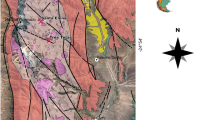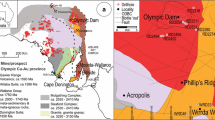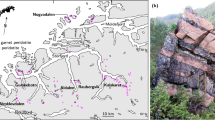Abstract
In-situ trace element analyses of fluorapatite, calcite, dolomite, olivine, and phlogopite have been undertaken on representative phoscorite and carbonatite rocks of the Palaeoproterozoic Phalaborwa Complex. Textural and compositional characterization reveals uniformity of fluorapatite and calcite among most of the intrusions, and seems to favor a common genetic origin for the phoscorite-carbonatite association. Representing major repositories for rare earth elements (REE), fluorapatite and calcite exhibit tightly correlated light REE (LREE) abundances, suggesting that partitioning of LREE into these rock forming minerals was principally controlled by simple igneous differentiation. However, light rare earth element distribution in apatite and calcite cannot be adequately explained by equilibrium and fractional crystallization and instead favors a complex crystallization history involving mixing of compositionally distinct magma batches, in agreement with previously reported mineral isotope variability that requires open-system behaviour.








Similar content being viewed by others
References
Bau M (1996) Controls on the fractionation of isovalent trace elements in magmatic and aqueous systems: evidence from Y/Ho, Zr/Hf, and lanthanide tetrad effect. Contrib Mineral Petrol 123:323–333
Belousova EA, Griffin WL, O’Reilly SY, Fisher NI (2002) Apatite as an indicator mineral for mineral exploration: Trace-element compositions and their relationship to host rock type. J Geochem Expl 76:45–69
Bizzarro M, Simonetti A, Stevenson RK, Kurszlaukis S (2003) In-situ 87Sr/86Sr investigation of igneous apatites and carbonates using laser ablation MC-ICP-MS. Geochim Cosmochim Acta 67:289–302
Boynton WV (1984) Rare Earth Element Geochemistry. Developments in Geochemistry. In: Henderson P (ed) Cosmochemistry of the rare earth elements: meteorite studies, vol 2. Elsevier, Amsterdam, pp. 115–152
Brassinnes S, Balaganskaya E, Demaiffe D (2005) Magmatic evolution of the differentiated ultramafic, alkaline and carbonatite intrusion of Vuoriyarvi (Kola Peninsula, Russia). A LA-ICP-MS study of apatite. Lithos 85:76–92
Brice WR, Chang LLY (1973) Subsolidus phase relations in aragonite-type carbonates. III. The systems MgCO3-CaCO3-BaCO3, MgCO3-CaCO3-SrCO3, and MgCO3-SrCO3-BaCO3. Am Mineral 58:979–985
Broom-Fendley S, Wall F, Brady AE, Gunn AG, Chenery SR, Dawes W (2013) Carbonatite-hosted late-stage apatite as a potential source of the heavy rare earth elements. SGA Conference Abstracts 4:1694–1698
Broom-Fendley S, Styles MT, Appleton JD, Gun G, Wall F (2016) Evidence for dissolution-reprecipitation of apatite and preferential LREE mobility in carbonatite-derived late-stage hydrothermal processes. Amer Mineral 101:596–611
Bühn B, Wall F, Le Bas MJ (2001) Rare-earth element systematics of carbonatitic fluorapatites, and their significance for carbonatite magma evolution. Contrib Mineral Petrol 41:572–591
Buick IS, Maas R, Gibson R (2001) Precise U–Pb titanite age constraints on the emplacement of the Bushveld Complex, South Africa. J Geol Soc Lond 158:3–6
Chakhmouradian AR, Williams CT (2004) Mineralogy of high-field-strength elements (Ti, Nb, Zr, Ta, Hf) in phoscoritic and carbonatitic rocks of the Kola Peninsula, Russia. In: Wall F, Zaitsev AN (eds) Phoscorites and carbonatites from mantle to mine: the key example of the Kola Alkaline Province. The Mineralogical Society Series 10, pp 293–340
Chakhmouradian AR, Reguir EP, Couëslan C, Yang P (2015a) Calcite and dolomite in intrusive carbonatites. II. Trace-element variations. Miner Petrol. doi:10.1007/s00710-015-0392-4
Chakhmouradian AR, Reguir EP, Kressall RD, Crozier J, Pisiak LK, Sidhu R, Yang P (2015b) Carbonatite-hosted niobium deposit at Aley, northern British Columbia (Canada): Mineralogy, geochemistry and petrogenesis. Ore Geol Rev 64:642–666
Chakhmouradian AR, Reguir EP, Zaitsev AN (2015c) Calcite and dolomite in intrusive carbonatites. I. Textural variations. Miner Petrol. doi:10.1007/s00710-015-0390-6
Chen W, Simonetti A (2013) In-situ determination of major and trace elements in calcite and apatite, and U–Pb ages of apatite from the Oka carbonatite complex: Insights into a complex crystallization history. Chem Geol 356:151–172
Cordeiro PFO, Brod JA, Dantas EL, Barbosa ER (2010) Mineral chemistry, isotope geochemistry and petrogenesis of niobium-rich rocks from the Catalão I carbonatite-phoscorite complex, Central Brazil. Lithos 118:223–237
Dare SAS, Barnes SJ, Beaudoin G, Meric J, Boutroy E, Potvin-Doucet C (2014) Trace elements in magnetite as petrogenetic indicators. Miner Deposita 49:785–796
Dawson JB, Hinton RW (2003) Trace-element content and partitioning in calcite, dolomite and apatite in carbonatite, Phalaborwa, South Africa. Mineral Mag 67:921–930
Downes H, Balaganskaya E, Beard A, Liferovich R, Demaiffe D (2005) Petrogenetic processes in the ultramafic, alkaline and carbonatitic magmatism in the Kola Alkaline Province. A review Lithos 85:48–75
Eby GN (1975) Abundance and distribution of the rare earth elements and yttrium in the rocks and minerals of the Oka carbonatite complex, Quebec. Geochim Cosmochim Acta 39:597–620
Eriksson SC (1982) Aspects of the petrochemistry of the Phalaborwa Complex, Northeastern Transvaal, South Africa. PhD thesis, University of the Witwatersrand, Johannesburg
Eriksson SC (1989) Phalaborwa: a saga of magmatism, metasomatism & miscibility. In: Bell K (ed) Carbonatites Genesis and Evolution. Unwin Hyman, London, pp. 221–254
Foley SF, Yaxley GM, Rosenthal A, Buhre S, Kiseeva ES, Rapp RP, Jacob DE (2009) The composition of near-solidus melts of peridotite in the presence of CO2 and H2O between 40 and 60 kbar. Lithos 112:274–283
Goldoff B, Webster JD, Harlov DE (2012) Characterization of fluor-chlorapatites by electron probe microanalysis with a focus on time-dependent intensity variation of halogens. Am Mineral 97:1103–1115
Groves DI, Vielreicher NM (2001) The Phalaborwa carbonatite-hosted magnetite-copper sulphide deposit, South Africa: an end-member of the iron-oxide copper-gold-rare element deposit group? Miner Deposita 36:89–194
Guzmics T, Zajacz Z, Kodolanyi J, Halter W, Szabo C (2008) LA-ICP-MS study of apatite- and K feldspar-hosted primary carbonatite melt inclusions in clinopyroxenite xenoliths from lamprophyres, Hungary: Implications for significance of carbonatite melts in the Earth’s mantle. Geochim Cosmochim Acta 72:1864–1886
Hammouda T, Chamtel J, Devidal J-L (2010) Apatite solubility in carbonatitic liquids and trace element partitioning between apatite and carbonatite at high pressure. Geochim Cosmochim Acta 74:7220–7235
Hanekom HJ, van Standen CM, Smit PJ, Pike DR (1965) The geology of the Palabora Igneous Complex, South Africa. Geological Survey Handbook Memoir 54
Hansen EC, Harlov DE (2007) Whole rock, phosphate, and silicate compositional trends across an amphibolite- to granulite-facies transition, Tamil Nadu, India. J Petrol 48:1641–1680
Harlov DE (2015) Apatite: a fingerprint for metasomatic processes. Elements 11:171–176
Harlov DE, Förster H-J (2002) High-grade fluid metasomatism on both a local and a regional scale: the Seward Peninsula, Alaska and the Val Strona di Omegna, Ivrea-Verbano Zone, northern Italy Part II: Phosphate mineral chemistry. J Petrol 43:801–824
Harlov DE, Förster H-J, Nijland TG (2002) Fluid-induced nucleation of (Y+REE)-phosphate minerals within apatite: nature and experiment. Part I. Chlorapatite. Am Mineral 87:245–261
Harlov DE, Förster H-J (2003) Fluid-induced nucleation of (Y+REE)-phosphate minerals within apatite: nature and experiment. Part II. Fluorapatite. Am Mineral 88:1209–1229
Harlov DE, Wirth R, Förster H-J (2005) An experimental study of dissolution–reprecipitation in fluorapatite: fluid infiltration and the formation of monazite. Contrib Mineral Petrol 150:268–286
Heaman LM (2009) The application of U–Pb geochronology to mafic, ultramafic and alkaline rocks: An evaluation of three mineral standards. Chem Geol 261:43–52
Heinrich EW (1970) The Phalaborwa carbonatitic complex – a unique copper deposit. Can Mineral 10:585–598
Hogarth DD (1989) Pyrochlore, apatite, amphibole: distinctive minerals in carbonatite. In: Bell K (ed) Carbonatites Genesis and Evolution. Unwin Hyman, London, pp. 105–148
Hornig-Kjarsgaard I (1998) Rare Earth Elements in sövitic carbonatites and their mineral phases. J Petrol 11-12:2105-2121
Hughes JM, Cameron M, Mariano AN (1991) Rare-earth-element ordering and structural variations in natural rare-earth-bearing apatites. Am Mineral 76:1165–1173
Ihlen PM, Schiellerup H, Gautneb H, Skår Ø (2014) Characterization of apatite resources in Norway and their REE potential - a review. Ore Geol Rev 58:126–147
Ionov D, Harmer RE (2002) Trace element distribution in calcite/dolomite carbonatites from Spitskop: inferences for differentiation of carbonatite magmas and the origin of carbonates in mantle xenoliths. Earth Planet Sci Lett 198:495–510
Jochum KP, Nehring F (2006a) BCR-2: GeoRem preferred values (11/2006), GeoRem (http://georem.mpch-mainz.gwdg.de)
Jochum KP, Nehring F (2006b) BHVO: GeoRem preferred values (11/2006), GeoRem (http://georem.mpch-mainz.gwdg.de)
Jochum KP, Nehring F (2006c) KL2-G: GeoRem preferred values (11/2006), GeoRem (http://georem.mpch-mainz.gwdg.de)
Klemme S (2003) Trace element partitioning between apatite and carbonatite melt. Am Mineral 88:639–646
Krasnova NI, Kopylova LN (1988) The geologic basis for mineral technological mapping at the Kovdor ore deposit. Int Geol Rev 30(307):319
Krasnova NI, Balaganskaya EG, Garcia D (2004a) Kovdor – classic phoscorites and carbonatites. In: Wall F, Zaitsev AN (eds) Phoscorites and Carbonatites from Mantle to Mine: the Key Example of the Kola Alkaline Province. The Mineralogical Society Series 10, pp 99-132
Krasnova NI, Petrov TG, Balaganskaya EG, Garcia D, Moutte J, Zaitsev AN, Wall F (2004b) Introduction to phoscorites: occurrence, composition, nomenclature and petrogenesis. In: Wall F, Zaitsev AN (eds) Phoscorites and Carbonatites from Mantle to Mine: the Key Example of the Kola Alkaline Province. The Mineralogical Society Series 10, pp 45-74
Kravchenko SM, Bagdasarov, YuA (1987) Geochemistry, mineralogy and genesis of apatite-bearing massifs (Maymeicha–Kotui carbonatite province). Nauka, Moscow (128 pp, in Russian)
Lombard AF, Ward-Able NM, Bruce RW (1964) The exploration and main geological features of the copper deposit in carbonatite at Loolekop, Palabora Complex. In: Haughton SH (ed) The Geology of Some Ore Deposits in Southern Africa 2, Geol. Soc. S. Afr., Johannesburg, pp 315-337
Martin LHJ, Schmidt MW, Mattson HB, Guenther D (2013) Element partitioning between immiscible carbonatite and silicate melts for dry and H2O-bearing systems at 1–3 GPa. J Petrol 54:2301–2338
Mao M, Rukhlov AS, Rowins SM, Spence J, Coogan LA (2016) Apatite Trace Element Compositions: A Robust New Tool for Mineral Exploration. Econ Geol 111:187–1222
Mariano AN, Mariano A (2012) Rare earth mining and exploration in North America. Elements 8:369–376
Milani L, Bolhar R, Cawthorn RG, Frei D (2016) In situ LA–ICP-MS and EPMA trace element characterization of Fe–Ti oxides from the phoscorite–carbonatite association at Phalaborwa, South Africa. Miner Deposita. doi:10.1007/s00126-016-0696-2
Otto JW, Wyllie PJ (1993) Relationships between silicate melts and carbonate-precipitating melts in CaO-MgO-SiO2-CO2-H2O at 2 kbar. Mineral Petrol 48:343–365
Palabora Mining Company Limited Mine Geological and Mineralogical staff (1976) The geology and the economic deposit of copper, iron, and vermiculite in the Palabora igneous complex: a brief review. Econ Geol 71:177–192
Pan Y, Fleet ME, MacRae ND (1993) Oriented monazite inclusions in apatite porphyroblasts from the Hemlo gold deposit, Ontario, Canada. Mineral Mag 57:697–707
Pan Y, Fleet ME (2002) Compositions of the apatite-group minerals: Substitution mechanisms and controlling factors. Rev Mineral Geochem 48:13–49
Pasero M, Kampf AR, Ferraris C, Pekov IV, Rakovan J, White TJ (2010) Nomenclature of the apatite supergroup minerals. Eur J Mineral 22:163–179
Prowatke S, Klemme S (2006) Trace element partitioning between apatite and silicate melts. Geochim Cosmochim Acta 70:4513–4527
Putnis A (2009) Mineral replacement reactions. Rev Mineral Geochem 70:87–124
Reguir EP, Chakhmouradian AR, Halden MN, Yang P, Zaitsev AN (2008) Early magmatic and reaction-induced trends in magnetite from the carbonatites of Kerimasi, Tanzania. Can Mineral 46:879–900
Reguir EP, Chakhmouradian AR, Halden NM, Malkovets VG, Yang P (2009) Major- and trace-element compositional variation of phlogopite from kimberlites and carbonatites as a petrogenetic indicator. Lithos 112:372–384
Reischmann T, Brugmann GE, Jochum KP, Todt WA (1995) Trace element and isotopic composition of baddeleyite. Mineral and Petrol 53:155–164
Ridge JD (1976) Annotated Bibliographies of Mineral Deposits in Africa, Asia, (Exclusive of USSR) and Australasia. Pergamon Press, pp 545
Rudashevsky NS, Kretser YuL, Rudashevsky VN, Sukharzhevskaya EA (2004) A review and comparison of PGE, noble-metal and sulphide mineralization in phoscorites and carbonatites from Kovdor and Phalaborwa. In: Wall F, Zaitsev AN (eds) Phoscorites and Carbonatites from Mantle to Mine: The Key Example of the Kola Alkaline Province. The Mineralogical Society of Great Britain and Ireland, pp 375-406
Russell HD, Hiemstra SA, Groeneveld D (1954) The mineralogy and petrology of the carbonatite at Loolekop, eastern Transvaal. Trans Geol Soc S Afr 57:97–208
Schärer U, Berndt J, Deutsch A (2011) The genesis of deep-mantle xenocrystic zircon and baddeleyite megacrysts (Mbuji-Mayi kimberlite): trace-element patterns. Eur J Mineral 23:241–255
Scoates JS, Friedman RM (2008) Precise age of the platiniferous Merensky Reef, Bushveld Complex, South Africa, by the U–Pb zircon chemical abrasion ID-TIMS technique. Econ Geol 103:465–471
Shramenko IF, Stadnik VA, Osadchii VK (1992) Geochemistry of carbonatites in the Ukrainian Shield. Naukova Dumka, Kiev (210 pp., in Russian)
Simonetti A, Bell K (1994) Nd, Pb and Sr isotopic data from the Napak carbonatite– nephelinite centre, eastern Uganda: an example of open-system crystal fractionation. Contrib Mineral Petrol 115:356–366
Simonetti A, Bell K (1995) Nd, Pb, and Sr isotopic data from the Tertiary Mount Elgon volcano, western Kenya-eastern Uganda: implications for the origin and evolution of nephelinitic melts. Lithos 36:141–153
Solovova IP, Ryabchikov ID, Kogarko LN, Kononkova NN (1998) Inclusions in Minerals of the Palaborwa Carbonatite Complex, South Africa. Geochemistry International 36:377–388
Stormer JCJ, Pierson MJ, Tacker RC (1993) Variation of F and Cl X-ray intensity due to anisotropic diffusion of apatite during electron microprobe analysis. Am Mineral 78:641–648
Van Rensburg WCJ (1965) Copper mineralization in the carbonate members and phoscorite, Phalaborwa, South Africa. PhD thesis, University of Winsconsin, Madison, pp 242
Verwoerd WJ, Du Toit MC (2006) The Phalaborwa and Schiel complexes. In: Johnson MR, Anhausser CR, Thomas RJ (eds) The Geology of South Africa, Council for Geosciences, pp 291-318
Wall F, Mariano A (1996) Rare earth minerals in carbonatites: A discussion centred on the Kangankunde carbonatite, Malawi. In: Jones A, Wall F, Williams CT (eds) Rare Earth Minerals: Chemistry Origin and Ore Deposits. Chapman and Hall, London, pp. 193–226
Wall F, Zaitsev AN (2004) Rare earth minerals in Kola carbonatites. In: Wall F, Zaitsev AN (eds) Phoscorites and Carbonatites from Mantle to Mine: the Key Example of the Kola Alkaline Province. The Mineralogical Society Series 10, pp 341–373
Walter A-V, Nahon D, Flicoteaux R, Girard J, Melfi A (1995) Behaviour of major and trace elements and fractionation of REE under tropical weathering of a typical apatite-rich carbonatite from Brazil. Earth Planet Sci Lett 136:591–602
Wang L-X, Marks MAW, Wenzel T, von der Handt A, Keller J, Teiber H, Markl G (2014) Apatites from the Kaiserstuhl Volcanic Complex, Germany: new constraints on the relationship between carbonatite and associated silicate rocks. Eur J Mineral 26:397–414
Williams CT (1996) The occurrence of niobian zirconolite, pyrochlore and baddeleyite in the Kovdor carbonatite complex, Kola Peninsula, Russia. Mineral Mag 60:639–646
Wu FJ, Yang YH, Li QL, Mitchell RH, Dawson JB, Brandl G, Yuhara M (2011) In situ determination of U-Pb ages and Sr-Nd-Hf isotopic constraints on the petrogenesis of the Phalaborwa carbonatite Complex, South Africa. Lithos 127:209–327
Xu C, Campbell IH, Allen CM, Huang Z, Qi L, Zhang H, Zhang G (2007) Flat rare earth element patterns as an indicator of cumulate processes in the Lesser Qinling carbonatites, China. Lithos 95:267–278
Xu C, Campbell IH, Kynicky J, Allen CM, Chen Y, Huang Z, Qi L (2008) Comparison of the Daluxiang and Maoniuping carbonatitic REE deposits with Bayan Obo REE deposit, China. Lithos 106:12–24
Yegorov LS (1984) Rare–element and fluorine contents of apatite and reflecting formation conditions, alteration and potential mineralization for rocks of the foscorite-carbonatite group in ijolite-carbonatite complexes. Internat Geol Rev 26:93–107
Yuhara M, Hirahara Y, Nishi N, Kagami H (2005) Rb–Sr, Sm–Nd ages of the Phalaborwa carbonatite complex, South Africa. Polar Geos 18:101–113
Zaitsev AN, Williams CT, Jeffries TE, Strekopytov S, Moutte J, Ivashchenkova OV, Spratt J, Petrov SV, Wall F, Seltmann R, Borozdin AP (2014) Rare earth elements in phoscorites and carbonatites of the Devonian Kola Alkaline Province, Russia: examples from Kovdor, Khibina, Vuoriyarvi and Turiy Mys complexes. Ore Geol Rev 61:204–225
Zeh A, Ovtcharova M, Wilson AH, Schaltegger U (2015) The Bushveld Complex was emplaced and cooled in less than one million years – results of zirconology, and geotectonic implications. Earth Planet Sci Lett 418:103–114
Zurevinski SE, Mitchell RH (2004) Extreme compositional variation of pyrochlore-group minerals at the Oka carbonatite complex, Quebec: evidence of magma mixing? Canad Mineral 42:1159–1168
Acknowledgements
LM and RB acknowledge funding from the DST-NRF Centre of Excellence for Integrated Mineral and Energy Resource Analysis (CIMERA). Sajeev Kirshnan is thanked for providing the use of the JEOL JXA-8230 SUPERPROBE at the Advanced Facility for Microscopy and Microanalysis, Indian Institute of Science, Bangalore. Constructive criticism by an anonymous reviewer, Antonio Simonetti, Associate Editor Robert Linnen and Editor-in-Chief Georges Beaudoin helped to improve the manuscript. Thanks are extended to Palabora Mining Company Ltd for kindly providing several of the studied rocks, in particular to Paulien Lourens and Thabitha Moyana, for very helpful assistance during LM and RB visits at Phalaborwa. Grant Cawthorn and Paul Nex (Wits University) are thanked for providing part of of the studied samples.
Author information
Authors and Affiliations
Corresponding author
Additional information
Editorial handling: R. Linnen
Electronic supplementary material
Online Resource 1
EPMA of fluorapatite at Phalaborwa. Abbreviations: Phos = phoscorite; BC = banded carbonatite; TC = transgressive carbonatite (PDF 72 kb)
Online Resource 2
Trace element compositions (in ppm), sigma errors, detection limits and mean cps of LA-ICP-MS analyses of fluorapatite and calcite at Phalaborwa. Abbreviations: Phos = phoscorite; BC = banded carbonatite; TC = transgressive carbonatite. In Italic: element contents likely related to contamination by microinclusions and not included in calculations in Table 3 (PDF 598 kb)
Online Resource 3
Trace element compositions (in ppm), sigma errors, detection limits and mean cps of LA-ICP-MS analyses of olivine and phlogopite at Phalaborwa. Abbreviations: Phos = phoscorite; BC = banded carbonatite; TC = transgressive carbonatite. In Italic: element contents likely related to contamination by microinclusions and not included in calculations in Table 3 (PDF 368 kb)
Rights and permissions
About this article
Cite this article
Milani, L., Bolhar, R., Frei, D. et al. Light rare earth element systematics as a tool for investigating the petrogenesis of phoscorite-carbonatite associations, as exemplified by the Phalaborwa Complex, South Africa. Miner Deposita 52, 1105–1125 (2017). https://doi.org/10.1007/s00126-016-0708-2
Received:
Accepted:
Published:
Issue Date:
DOI: https://doi.org/10.1007/s00126-016-0708-2




